Anybody Can Play PIANO
Anybody Can Play PIANO
Piano in Preschools
TEACHING PIANO IN THE PRESCHOOL ENVIRONMENT
WITH THE ANYBODY CAN PLAY APP and VIDEOS
This page gives a preschool information and advice about:
1. Why do a program like this and
2. How to implement it.
TOPICS
WHY BOTHER?
EQUIPMENT NEEDED
IMPLEMENTING PROGRAM
USING THE LESSON VIDEOS
USING THE Anybody Can Play PIANO APP
WHY BOTHER?
BRAIN DEVELOPMENT: Multiple studies have shown that piano lessons begun at a young age dramatically increase brain development, so this is a wonderful gift to give to not only the children in your care, but to their parents.
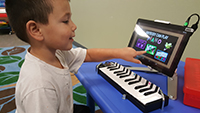 WORKING PARENTS:
Generally you are dealing with working parents.
If the preschool is doing activities that enhance the Anybody Can Play PIANO app and teaching the children how to use the app, parents can subscribe to the app at home with a child that already knows how to work on it independently. All the parents have to do then is remember to compliment their child on good work!....with maybe some type of "reward" for a particular job well done?
WORKING PARENTS:
Generally you are dealing with working parents.
If the preschool is doing activities that enhance the Anybody Can Play PIANO app and teaching the children how to use the app, parents can subscribe to the app at home with a child that already knows how to work on it independently. All the parents have to do then is remember to compliment their child on good work!....with maybe some type of "reward" for a particular job well done?
MARKETING: If you are at capacity, doing this piano program shows you really are concerned with benefits for the children in your care and are continually trying to do your best! I just read an article about preschool marketing and the number one concern of parents is quality care. I would certainly think that giving their child increased brain development would certainly qualify as one form of quality care!
If you are not at capacity, this is a tremendous marketing tool...."Free piano lessons for EVERY child ages 3 and up!" Just remember to do the program super well to create not only reviews, but excellent reviews!
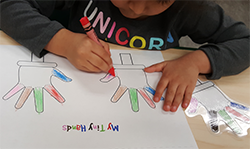 SHARING WITH FAMILIES:
This is also a way to share activities with families. You help them by doing the group activities and they help you by letting their child expand their practice time on the app at home. Children can then share at school what they have learned at home. It is quite amazing what some children can do and I have had countless grateful parents come to me over the years to thank me for exposing their child to piano at such a young age.
SHARING WITH FAMILIES:
This is also a way to share activities with families. You help them by doing the group activities and they help you by letting their child expand their practice time on the app at home. Children can then share at school what they have learned at home. It is quite amazing what some children can do and I have had countless grateful parents come to me over the years to thank me for exposing their child to piano at such a young age.
CONFIDENCE BUILDER: Learning to play the piano is a great confidence builder for children which makes them much more ready to learn new skills. It is also an outlet for creativity. In fact, Piano Lesson 8 shows the children how to "write down" their own created song so they can keep it and also share it with others.
EQUIPMENT NEEDED
APP AND COMPUTER1. The Anybody Can Play PIANO app (Cost: $1.99 per month).
To subscribe to the Anybody Can Play PIANO app in Windows 10 click here
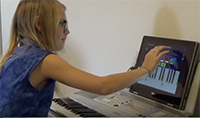 2. A COMPUTER OR TABLET UTILIZING WINDOWS 10; MINIMUM 4G: Some schools use only Apple products. This program, however, justifies obtaining a computer used just for these piano lessons. Preferably the "piano computer" should be set up for use all day every day since this program is also something of interest for those after-schoolers too! Any computer 4G or greater that utilizes Windows 10 works great. I even saw a mini computer (compared in size to a peanut butter sandwich!) on Amazon for only $66.00! - just need a monitor to go with it.
2. A COMPUTER OR TABLET UTILIZING WINDOWS 10; MINIMUM 4G: Some schools use only Apple products. This program, however, justifies obtaining a computer used just for these piano lessons. Preferably the "piano computer" should be set up for use all day every day since this program is also something of interest for those after-schoolers too! Any computer 4G or greater that utilizes Windows 10 works great. I even saw a mini computer (compared in size to a peanut butter sandwich!) on Amazon for only $66.00! - just need a monitor to go with it.
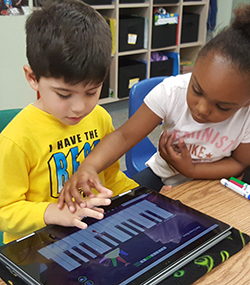 If the computer is touch sensitive there is no need for anything else. It might be easier for the very young children to use a touch sensitive screen, but I have found that they are very anxious to use a "real" piano keyboard. I asked one three year old if she needed a color coded "key strip" to help her find the proper keys on the piano keyboard in order to play a particular song. She looked at me, smiled and said "I don't need it. I can do it." And, she did!
If the computer is touch sensitive there is no need for anything else. It might be easier for the very young children to use a touch sensitive screen, but I have found that they are very anxious to use a "real" piano keyboard. I asked one three year old if she needed a color coded "key strip" to help her find the proper keys on the piano keyboard in order to play a particular song. She looked at me, smiled and said "I don't need it. I can do it." And, she did!
If the computer/tablert is not touch sensitive then an attached MIDI keyboard or keyboard controller is necessary for the Teach Me and Notes part of the app. If using a MIDI keyboard, just remember to turn off the keyboard's sound because the sound will still be coming through the computer.
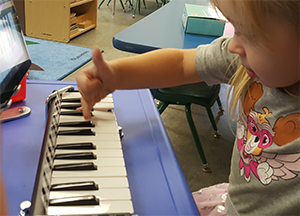 You have noticed in photos that most children are using actual piano keyboards or mini sized keyboard controllers. That little 3 year old in the photo may not have the best hand position at this point, but she is actually playing a song using the screen prompts. My recommendation is to use an attached keyboard as soon as possible so those fingers get used to pushing down a key rather than just touching a screen.
You have noticed in photos that most children are using actual piano keyboards or mini sized keyboard controllers. That little 3 year old in the photo may not have the best hand position at this point, but she is actually playing a song using the screen prompts. My recommendation is to use an attached keyboard as soon as possible so those fingers get used to pushing down a key rather than just touching a screen.
LAMINATOR: Many of the activity/game sheets will be used multiple times, so a laminator is needed. Many preschools have big laminators. If it is too difficult to laminate cards, etc. it would probably be a good idea to get a small laminator that laminates up to 5mm. That way laminator pouches that are card sized, page sized, etc. could be easily laminated. Keep in mind that all these activity and game sheets are free. If they were purchased in a form ready to use they would be very expensive!
IMPLEMENTING THE PROGRAM
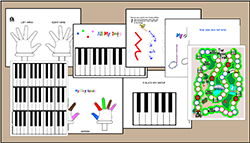 PERSON "IN CHARGE": The Anybody Can Play PIANO program can be done with ages 3 and up, so there needs to be a staff person who keeps a record of progress for each class and prepares appropriate activity/game sheets as needed for each age group on a daily basis. This person even needs to bring the sheets to each classroom...a reminder for teachers to do the activity.
PERSON "IN CHARGE": The Anybody Can Play PIANO program can be done with ages 3 and up, so there needs to be a staff person who keeps a record of progress for each class and prepares appropriate activity/game sheets as needed for each age group on a daily basis. This person even needs to bring the sheets to each classroom...a reminder for teachers to do the activity.
MATERIAL STORAGE: This "in charge" person also needs to organize and store materials. Stackable, labeled, page-size plastic boxes with lids are great - especially for laminated materials that are used multiple times!
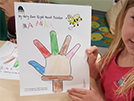 CLASSROOM DISPLAY: Finished activity sheets should be prominantly displayed. Bulletin board displays are great. Peg board displays are really good as well since they also double for storage of imminant activity sheets, games and laminated reminders (like the little colored hands) so the children are visually exposed to things they are to remember.
CLASSROOM DISPLAY: Finished activity sheets should be prominantly displayed. Bulletin board displays are great. Peg board displays are really good as well since they also double for storage of imminant activity sheets, games and laminated reminders (like the little colored hands) so the children are visually exposed to things they are to remember.
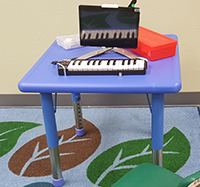 APP/PIANO SET UP: If the school only has one app/piano set up for the entire school, this person also needs to make sure someone is moving the "piano station" from room to room at scheduled times throughout the day, or that the teachers are somehow letting children have access to the app during the day.
APP/PIANO SET UP: If the school only has one app/piano set up for the entire school, this person also needs to make sure someone is moving the "piano station" from room to room at scheduled times throughout the day, or that the teachers are somehow letting children have access to the app during the day.
This photo shows a little piano station used in a preschool for the 3's and 4's so is moved at least once during the day. It is extremely portable - light but stable - fits easily through the doors. There is a video about building this little piano station in the Anybody Can Play PIANO General Info Playlist. To look at that video click here.
USING THE LESSON VIDEOS
THOSE VIDEOS: When most people think of "piano lessons" they think in terms of one lesson per week. So, as mentioned on the Piano Lesson page, looking at the activities and materials needed for lesson 1 may seem overwhelming. A better name would be: The First Few Steps"Each Lesson page discusses the video and has direct access to the videos and activity aheets. However, so you are fully aware that these Lessons are not meant to be done in their entirety all at once, here is a quick overview of the first 2 minutes of the 9 1/2 minute Lesson One Video.
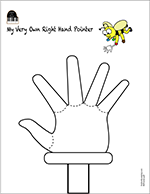
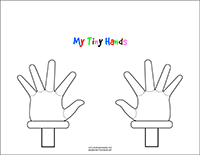 FIRST MINUTE: LESSON ONE: The first minute of the Piano Lesson 1 video covers the first two fingers that are color coded - the blue and pink finger colors. The only activity sheet needed is the tiny hands activity sheet. The children color only the pink and blue fingers on the right hand in the beginning. If you would rather use the right hand only sheet seen on the picture of that cute little guy, just click on The Right Hand Pointer Hand
RHPointer to print out.
FIRST MINUTE: LESSON ONE: The first minute of the Piano Lesson 1 video covers the first two fingers that are color coded - the blue and pink finger colors. The only activity sheet needed is the tiny hands activity sheet. The children color only the pink and blue fingers on the right hand in the beginning. If you would rather use the right hand only sheet seen on the picture of that cute little guy, just click on The Right Hand Pointer Hand
RHPointer to print out.
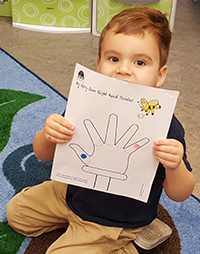 For very young children who do not color well yet, use pink and blue stickers. They can be stickers with a design on them if you wish, but they have to be primarily pink and blue and only referred to as "pink" and "blue". You can also make these stickers by using a sheet of small white stickers and coloring them with a permanent marker....something else for the "Person in Charge" to do:)
For very young children who do not color well yet, use pink and blue stickers. They can be stickers with a design on them if you wish, but they have to be primarily pink and blue and only referred to as "pink" and "blue". You can also make these stickers by using a sheet of small white stickers and coloring them with a permanent marker....something else for the "Person in Charge" to do:)
As a side note here, if children have difficulty discerning the difference between blue and green or red and pink, use stickers that are shaped - like a blue star, green square, etc. Refer to these colors then as "blue star", "green square" so they start seeing the subtle color differences.
Have an activity sheet "finished" with the pink and blue colors on display so the children are visually reminded of those colors.
Review this concept until the children know these colors without any hesitation.....a week?.....2 weeks?
SECOND MINUTE: LESSON ONE: The second minute of the Piano Lesson 1 video covers the Tick Tock song (on videos) and tapping blue and pink fingers on the table. These two activities are totally self explanatory. All singing (with or without the videos) should be done with motion....big clocks, little clocks, teeny weeny clocks, middle sized clocks... Singing and tapping correct fingers at the same time is the goal here.
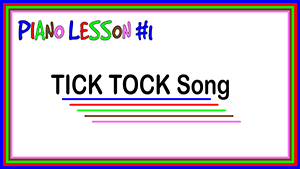 Again, review these activities until the children sing the words, sing the colors, and tap the finger colors with ease. Then, continue with Lesson One, or skip to Lesson Two Patterning as is mentioned on the Lesson Page.
Again, review these activities until the children sing the words, sing the colors, and tap the finger colors with ease. Then, continue with Lesson One, or skip to Lesson Two Patterning as is mentioned on the Lesson Page.
PREP VIDEO: I recommend that you view the Parent/Teacher PREP for ONLINE PIANO LESSON ONE VIDEO. However, do keep in mind that you are looking at many weeks of lesson activities.
VIEWING VIDEOS: It is important that all staff members are not only familiar with the use of the app, but familiar with the videos. Most preschool staff members have not had a music background, so this piano instruction is all new to them as well. Take it slowly, but learn it well.
The videos are all short, so a video or portion of a video could be shown at staff meetings. It doesn't have to be a Lesson Video....could just be a couple of those little song videos that last about a minute each!
New staff members will, however, have to methodically and repeatedly go through the app and videos until they are familiar with the activities up to the point of the children's knowledge.
USING THE Anybody Can Play PIANO APP
Books have been written about how actually learning to play the piano tremendously increases brain fuction. Besides giving children the gift of making music, increasing brain function is our primary goal!The Anybody Can Play PIANO app parallels language development. When a child learns to say his/her first word, parents become excited and the child uses that word over and over. When another word is spoken, both words are used over and over. There is always progression.
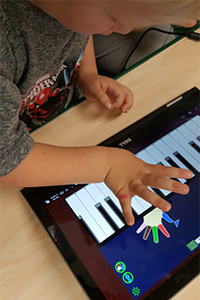 If a child can play a song on the app with the arrows turned off and continues to play that song even after "moving on" to the next song, the memory reflex is being developed. If this process is continued, later more complicated songs become as easy to memorize as that first simple Tick Tock. This is an incredible skill that transfers to other subjects! So, encourage students to keep playing what they already know so they can improve the way they play it....or can play a whole "string" of songs....or help another child...or....
If a child can play a song on the app with the arrows turned off and continues to play that song even after "moving on" to the next song, the memory reflex is being developed. If this process is continued, later more complicated songs become as easy to memorize as that first simple Tick Tock. This is an incredible skill that transfers to other subjects! So, encourage students to keep playing what they already know so they can improve the way they play it....or can play a whole "string" of songs....or help another child...or....
Try to give each child the opportunity to individually use the app. This may not always be possible, but do strive for that goal...and try to get parent involvement so children have access to the app at home as well.
You will notice that this very young child's teacher marked his fingers with a washable marker. This was before the video Tick Tock song was available, allowing the children to sing the colors with kk. Since then no fingers have had to be marked....amazing!
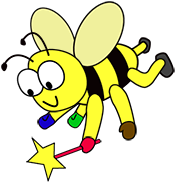
Anybody Can Play PIANO APP
To subscribe to the Anybody Can Play PIANO app in Windows 10 click here.First week is free - $1.99/mo to continue.
EZPianoNotes
EZ Piano Notes features Busy Buzzy Bumblbee for enhancing the learning of notes.To subscribe click here. First week free - then $1.99 total cost.